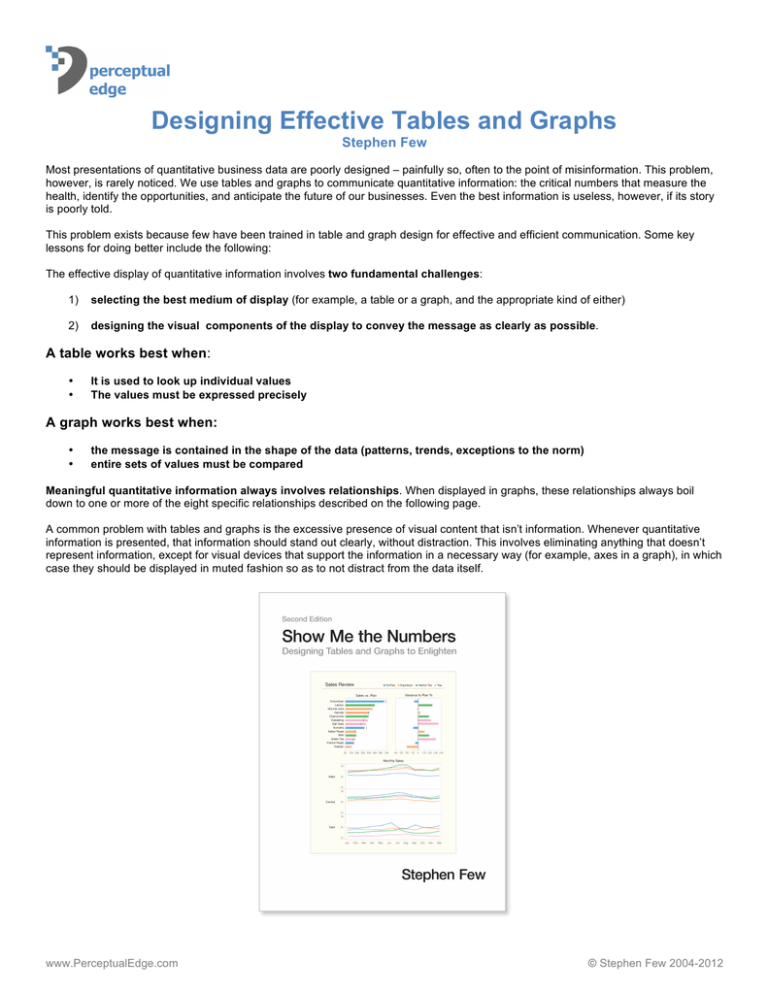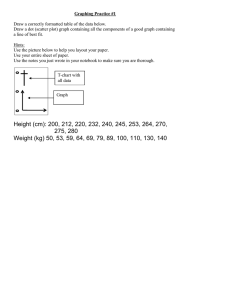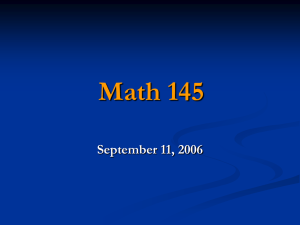Designing Effective Tables and Graphs Stephen Few
advertisement

Designing Effective Tables and Graphs Stephen Few Most presentations of quantitative business data are poorly designed – painfully so, often to the point of misinformation. This problem, however, is rarely noticed. We use tables and graphs to communicate quantitative information: the critical numbers that measure the health, identify the opportunities, and anticipate the future of our businesses. Even the best information is useless, however, if its story is poorly told. This problem exists because few have been trained in table and graph design for effective and efficient communication. Some key lessons for doing better include the following: The effective display of quantitative information involves two fundamental challenges: 1) selecting the best medium of display (for example, a table or a graph, and the appropriate kind of either) 2) designing the visual components of the display to convey the message as clearly as possible. A table works best when: • • It is used to look up individual values The values must be expressed precisely A graph works best when: • • the message is contained in the shape of the data (patterns, trends, exceptions to the norm) entire sets of values must be compared Meaningful quantitative information always involves relationships. When displayed in graphs, these relationships always boil down to one or more of the eight specific relationships described on the following page. A common problem with tables and graphs is the excessive presence of visual content that isn’t information. Whenever quantitative information is presented, that information should stand out clearly, without distraction. This involves eliminating anything that doesn’t represent information, except for visual devices that support the information in a necessary way (for example, axes in a graph), in which case they should be displayed in muted fashion so as to not distract from the data itself. www.PerceptualEdge.com © Stephen Few 2004-2012 Graph Selection Matrix Value-Encoding Objects Points Lines Bars Boxes Bar Graph (vertical) Featured Relationships Time Series Values display how something changed through time (yearly, monthly, etc.) Ranking Values are ordered by size (descending or ascending) Part-to-Whole Dot Plot Box Plot (vertical) Line Graph Scatter Plot Bar Graph (horizontal) Line Graph with Points Strip Plot Box Plot (horizontal) Yes (as a dot plot, when you don’t have a value for every interval of time) Yes (to feature overall trends and patterns and to support their comparisons) Yes (vertical bars only, to feature individual values and to support their comparisons) Yes (vertical boxes only, to display how a distribution changes through time) Yes (as a dot plot, especially when the quantitative scale does not begin at zero) No No Yes Yes (to display a ranked set of distributions) No Yes No Yes (as a dot plot, especially when the quantitative scale does not begin at zero) Yes (when also featuring a time series) Yes No Yes (as a strip plot, to feature individual values) Yes (as a frequency polygon, to feature the overall shape of the distribution) Yes Yes (when comparing multiple distributions) Yes (as a scatter plot) No Yes (as a table lens, especially when your audience is not familiar with scatter plots) No Yes (as bubbles of various sizes on a map) Yes (to display routes on a map) No No Yes (as a dot plot, especially when the quantitative scale does not begin at zero) No Yes No Values represent parts (proportions) of a whole (for example, regional portions of total sales) Deviation The difference between two sets of values (for example, the variance between actual and budgeted expenses) Distribution Counts of values per interval from lowest to highest (for example, counts of people by age intervals of 10 years each) Correlation Comparison of two paired sets of values (for example, the heights and weights of several people) to determine if there is a relationship between them Geospatial Values are displayed on a map to show their location Nominal Comparison A simple comparison of values for a set of unordered items (for example, products, or regions) www.PerceptualEdge.com Derived from the book Show Me the Numbers, Second Edition © Stephen Few 2004-2012




